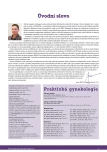-
Medical journals
- Career
Chronic viral hepatitis in pregnancy.
Authors: M. Oltman 1; L. Kužela 1; P. Jarčuška 2; T. Novotná 3
Authors‘ workplace: Gastroenterologicko‑Hepatologické centrum THALION, Bratislava 1; I. interná klinika Lekárskej fakulty P. J. Šafárika, Košice 2; Gastroenterologická klinika Slovenskej zdravotníckej univerzity, Bratislava 3
Published in: Prakt Gyn 2009; 13(1): 34-39
Overview
Chronic viral hepatitis in pregnancy can be potentially very dangerous not only for the mother, but also for the developing child. It is therefore very important to perform timely serological and virological diagnosis which helps estimate the risk of infection for the developing infant as well as the infection transmitted perinataly. At the same time preventive measures can be in advance assessed at delivery. It is also necessary to classify the amount of destruction of mother’s liver, if not too far advanced, does not mean any greater risk. Specific therapy of chronic viral hepatitis is limited, most medication is not appropriate according to the classification (e. g. FDA) and therefore prevention in the form of inoculation is necessary (tab. 1), [12].
Key words:
chronic viral hepatitis – pregnancy – therapy – prevention – inoculation
Sources
1. ACOG educational bulletin. Viral hepatitis in pregnancy. American College of Obstetricians and Gynecologists. Int J Gynaecol Obstet 1998; 63(248): 195–202.
2. Aggarwal N, Sawnhey H, Suril V et al. Pregnancy and cirrhosis of the liver. NZJ Obstet Gynaecol 1999; 4(39): 503–506.
3. Bjoro K et al. Hepatitis C infection in patients with primary hypogammaglobulinemia after treatment with contaminated immune globulin. N Engl J Med 1994; 331 : 1607–1611.
4. Briggs GG, Freeman RK, Yaffe SJ. Drugs in Pregnancy and Lactation. 5. ed. Baltimore: Williams and Wilkins 1998.
5. Centers for Disease Control and Prevention Sexually Transmitted Diseases Treatment Guidelines, 2002. MMWR May 10, 2001; R06 : 1–80.
6. Dienstag JL. Sexual and perinatal transmission of hepatitis C. Hepatology 1997; 26 : 66–70.
7. Ferrero S, Lungaro P, Bruzzone BM et al. Prospective study of mother-to-infant transmission of hepatitis C virus: a 10-year survey (1990–2000). Acta Obstet Gynecol Scand 2003; 82(3): 229–234.
8. Harnett MJ, Miller AD, Hurley RJ et al. Pregnancy, labour and delivery in a Jehovah‘s Witness with esophageal varices and thrombocytopenia. Can J Anaesth 2000; 47(12): 1253–1255.
9. Knopp RH, Bergelin RO, Wahl PW et al. Clinical chemistry alterations in pregnancy and oral contraceptive use. Obstet Gynecol 1985; 66 : 682–690.
10. Meisel H, Reip A, Faltus B et al. Transmission of hepatitis C virus to children and husbands by women infected with contaminated anti‑D immunoglobulin. Lancet 1995; 345 : 1209–1211.
11. Vento S, Nobili V, Cainelli F. Clinical course of infection with hepatitis C. BMJ 2006; 332(7538): 374–375.
12. Tajiri H, Miyoshi Y, Funada S et al. Prospective study of mother–to–infant transmission of hepatitis C virus. Pediat Infect Dis J 2001; 20 : 10–14.
Labels
Paediatric gynaecology Gynaecology and obstetrics Reproduction medicine
Article was published inPractical Gynecology

2009 Issue 1-
All articles in this issue
- Identification of the antigen Ki-67 in the atrophic endometrium and in serous carcinoma
- Upper Limb Lymphedema after Brest Cancer Therapy
- Hysteroscopy in diagnostics and therapy in infertile patients.
- The effect of cigarette smoking on clinical results of assisted reproduction: a meta-analysis.
- Untypical Course of Pneumonia in Pregnancy: a Case Report
- Influence of low dose aspirin on IVF/ICSI treatment.
- Chronic viral hepatitis in pregnancy.
- Forensic Aspects of Assisted Reproduction in Czech and Slovak Legislation.
- Practical Gynecology
- Journal archive
- Current issue
- Online only
- About the journal
Most read in this issue- Untypical Course of Pneumonia in Pregnancy: a Case Report
- Hysteroscopy in diagnostics and therapy in infertile patients.
- Upper Limb Lymphedema after Brest Cancer Therapy
- Forensic Aspects of Assisted Reproduction in Czech and Slovak Legislation.
Login#ADS_BOTTOM_SCRIPTS#Forgotten passwordEnter the email address that you registered with. We will send you instructions on how to set a new password.
- Career

